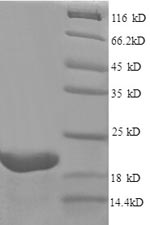This recombinant mouse Fibroblast growth factor 2 (Fgf2) comes from E. coli and spans the complete mature protein sequence from amino acids 10 to 154. The protein carries an N-terminal 6xHis tag, which helps with purification and detection. SDS-PAGE analysis confirms it reaches over 90% purity, making it appropriate for research applications. This product is designed strictly for research purposes and appears to deliver consistent quality.
Fibroblast growth factor 2 (Fgf2) belongs to the fibroblast growth factor family and plays important roles in cellular growth, differentiation, and angiogenesis. It participates in several critical biological pathways, particularly wound healing and tissue repair. The significance of Fgf2 in developmental biology and regenerative medicine research may make it a useful tool for investigating cellular processes and exploring potential therapeutic strategies.
Potential Applications
Note: The applications listed below are based on what we know about this protein's biological functions, published research, and experience from experts in the field. However, we haven't fully tested all of these applications ourselves yet. We'd recommend running some preliminary tests first to make sure they work for your specific research goals.
Based on the provided information, the recombinant Mouse FGF-2 is expressed in E. coli, a prokaryotic system that is generally unsuitable for producing properly folded eukaryotic growth factors like FGF-2. FGF-2 requires precise folding with three disulfide bonds for its receptor binding and bioactivity. While E. coli can express the protein, it often fails to form correct disulfide bonds without specialized strains or folding conditions. The protein contains the full-length mature sequence (10-154aa) with an N-terminal 6xHis tag, but the tag may interfere with the receptor-binding domain. Since activity is explicitly unverified and E. coli typically produces inactive FGF-2 without proper refolding, the protein is highly likely to be misfolded and inactive without experimental validation.
1. Protein-Protein Interaction Studies Using His-Tag Pull-Down Assays
The N-terminal 6xHis-tag technically enables pull-down experiments, but if FGF-2 is misfolded (as expected in E. coli), it will not interact physiologically with FGF receptors or heparin sulfate proteoglycans. Identified interactions may be non-specific artifacts. This application should not be pursued without prior validation of proper folding and receptor binding activity. If used without validation, results will likely be misleading.
2. Antibody Development and Validation
This application is appropriate. The recombinant FGF-2 can serve as an immunogen for generating antibodies that recognize linear epitopes, even if misfolded. The >90% purity supports immunization protocols. However, antibodies may not recognize conformational epitopes of native, properly folded FGF-2. Validation against bioactive FGF-2 from mammalian expression systems is essential for physiological relevance.
3. Biochemical Characterization and Biophysical Analysis
This application is valuable for assessing the protein's state. Techniques like circular dichroism can reveal if secondary structure is present, while dynamic light scattering may detect aggregation. However, without activity validation, these studies characterize the recombinant product but cannot confirm native folding. It should be noted that these are quality control measures, not functional validation.
4. Comparative Species Analysis and Evolutionary Studies
This application is problematic without activity confirmation. If the mouse FGF-2 is misfolded, cross-species binding comparisons will yield invalid evolutionary insights. Structural comparisons require properly folded proteins from all species being compared. This application should be deferred until proper folding and bioactivity are demonstrated.
Final Recommendation & Action Plan
Given the high probability of misfolding in E. coli for this disulfide bond-dependent growth factor, the protein should first be characterized for structural integrity (circular dichroism, mass spectrometry for disulfide bonds) and functionally validated using a cell-based proliferation assay or receptor binding assay. If inactive, it may be useful only for antibody production or as a negative control; if active, it can be used for interaction studies. For reliable FGF-2 research, consider obtaining the protein from a mammalian expression system with verified activity. Always include proper controls (e.g., commercial bioactive FGF-2) in experiments.






